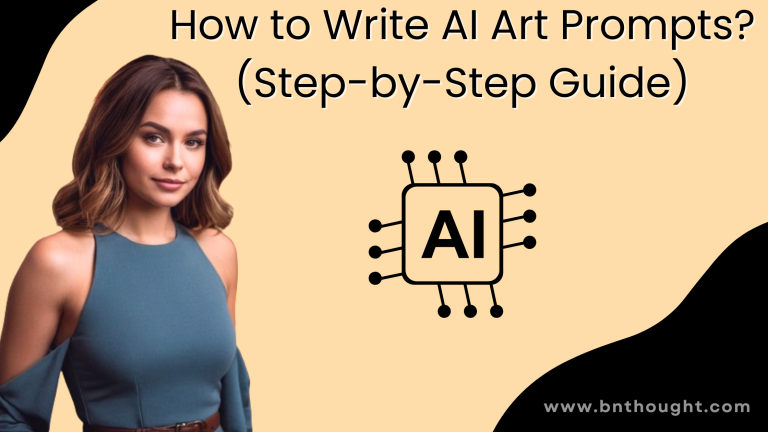
How to Write AI Art Prompts?
How to Write AI Art Prompts?. Writing AI art prompts is an essential skill for anyone looking to generate captivating and relevant artwork using artificial intelligence. These prompts serve as the blueprint that guides the AI in creating images, ensuring the output aligns with your vision. Whether you’re a digital artist, a content creator, or simply someone interested in the intersection of art and technology, mastering the art of prompt writing can significantly enhance your creative process.
1. Understanding AI Capabilities
Before diving into writing prompts, it’s crucial to understand the capabilities and limitations of the AI you’re working with. Not all AI art generators are created equal, and each has its strengths and weaknesses.
Knowing the AI’s Strengths and Limitations
Different AI models excel in various areas. Some might be better at generating realistic portraits, while others might excel in abstract art. Familiarize yourself with the AI’s strengths to tailor your prompts accordingly.
Experimenting with AI
Start by experimenting with the AI. Try generating a few simple prompts and observe the results. This hands-on approach helps you understand how the AI interprets different types of descriptions and adjusts your prompts for better outcomes.
2. Choosing a Theme or Concept
A clear theme or concept is the foundation of a successful AI art prompt. It provides direction and focus, ensuring the AI generates artwork that meets your expectations.
Importance of a Clear Theme
A well-defined theme helps the AI understand the context and main idea of the artwork. Whether it’s a fantasy landscape, a futuristic cityscape, or a character portrait, having a specific theme is crucial.
Examples of Themes
- Fantasy Landscape: Enchanted forests, magical realms, mythical creatures.
- Futuristic Cityscape: Neon-lit cities, advanced technology, urban sprawl.
- Character Portrait: Warriors, royalty, mythical beings.
3. Defining the Subject
The subject of the artwork is the main focus and should be described in detail to guide the AI effectively.
Main Elements of the Artwork
Identify the primary elements of your artwork. This could be a character, a specific scene, or an object that stands out.
Specific Details to Include
Include details such as colors, shapes, sizes, and positions. For example, if you’re describing a warrior, mention their armor, weapons, and stance.
4. Adding Context and Background
The context and background provide additional layers of information that help the AI generate a more coherent and engaging image.
Describing the Environment
Describe the environment where the subject is placed. Is it a bustling city, a serene countryside, or an abstract space?
Setting the Scene with Time and Season
Mentioning the time of day or season can significantly influence the mood and lighting of the artwork. A sunset scene will have different colors and shadows compared to a midday scene.
5. Specifying the Art Style
The art style dictates the overall look and feel of the artwork. Different styles can evoke different emotions and suit various purposes.
Different Art Styles
- Realistic: Highly detailed and true-to-life representations.
- Cartoonish: Simplified and exaggerated features for a playful feel.
- Impressionistic: Loose brushwork and emphasis on light and color.
6. Referencing Well-Known Artists
If you want the AI to mimic a particular style, reference well-known artists or art movements. For example, “in the style of Van Gogh” or “inspired by surrealism.”
Incorporating Emotions and Moods
Emotions and moods add depth to the artwork and make it more relatable and impactful.
Setting the Emotional Tone
Describe the emotional tone you want the artwork to convey. Is it happy, melancholic, eerie, or serene?
Using Atmospheric Elements
Elements like weather, lighting, and color schemes can help set the mood. For example, a stormy sky can create a sense of tension, while soft, pastel colors can evoke tranquility.
7. Using Descriptive Language
Descriptive language paints a vivid picture in the AI’s “mind,” leading to more accurate and engaging artwork.
Vivid and Sensory-Rich Descriptions
Use sensory-rich descriptions that appeal to sight, sound, touch, taste, and smell. For example, “a lush forest with the scent of pine and the sound of rustling leaves.”
Avoiding Ambiguity
Be clear and concise to avoid any ambiguity. The AI needs precise instructions to generate the desired outcome.
8. Providing Examples and References
Examples and references can help clarify your vision and guide the AI more effectively.
Using Reference Images
If possible, provide reference images. These visuals can serve as a benchmark for the AI, ensuring it aligns with your expectations.
Comparisons to Well-Known Artworks
Use comparisons to well-known artworks or scenes to help the AI understand your vision. For example, “a scene reminiscent of Splendid Night by Van Gogh.”




9. Common Mistakes to Avoid
Avoid these common pitfalls to ensure your prompts are effective and clear.
Overly Vague Descriptions
Vague descriptions lead to unpredictable results. Be specific about what you want to see in the artwork.
Inconsistent Details
Ensure all details in your prompt are consistent. Inconsistencies can confuse the AI and result in incoherent artwork.
10. Tips for Effective AI Art Prompts
Here are some tips to help you write more effective prompts.
Be Clear and Specific
Clarity and specificity are key. Provide as much detail as possible to guide the AI accurately.
Test and Refine Your Prompts
Don’t hesitate to test and refine your prompts. The more you analyze, the better you’ll comprehend how to make powerful prompts.
11. Real-World Examples
Examining real-world examples can provide insights into what makes a successful AI art prompt.
Successful AI Art Prompts
Analyze prompts that have led to successful artworks. Identify the elements that worked well.
Analyzing What Worked
Look for patterns in successful prompts. What details and descriptions made them effective?
12. Advanced Techniques
For more complex and nuanced artwork, consider using advanced techniques.
Layering Prompts for Complexity
Layer multiple prompts to create more complex and detailed artwork. For example, start with a basic scene and add layers of detail gradually.
Using Metaphors and Similes
Metaphors and similes can add richness to your descriptions. For example, “a sky as savage as a vicious ocean.”
How to Write the Best AI Art Prompts. Read More... Conclusion
Writing effective AI art prompts is both an art and a science. By understanding the AI’s capabilities, choosing clear themes, and providing detailed descriptions, you can guide the AI to create stunning and relevant artwork. Don’t be afraid to experiment and refine your prompts to achieve the best results.

